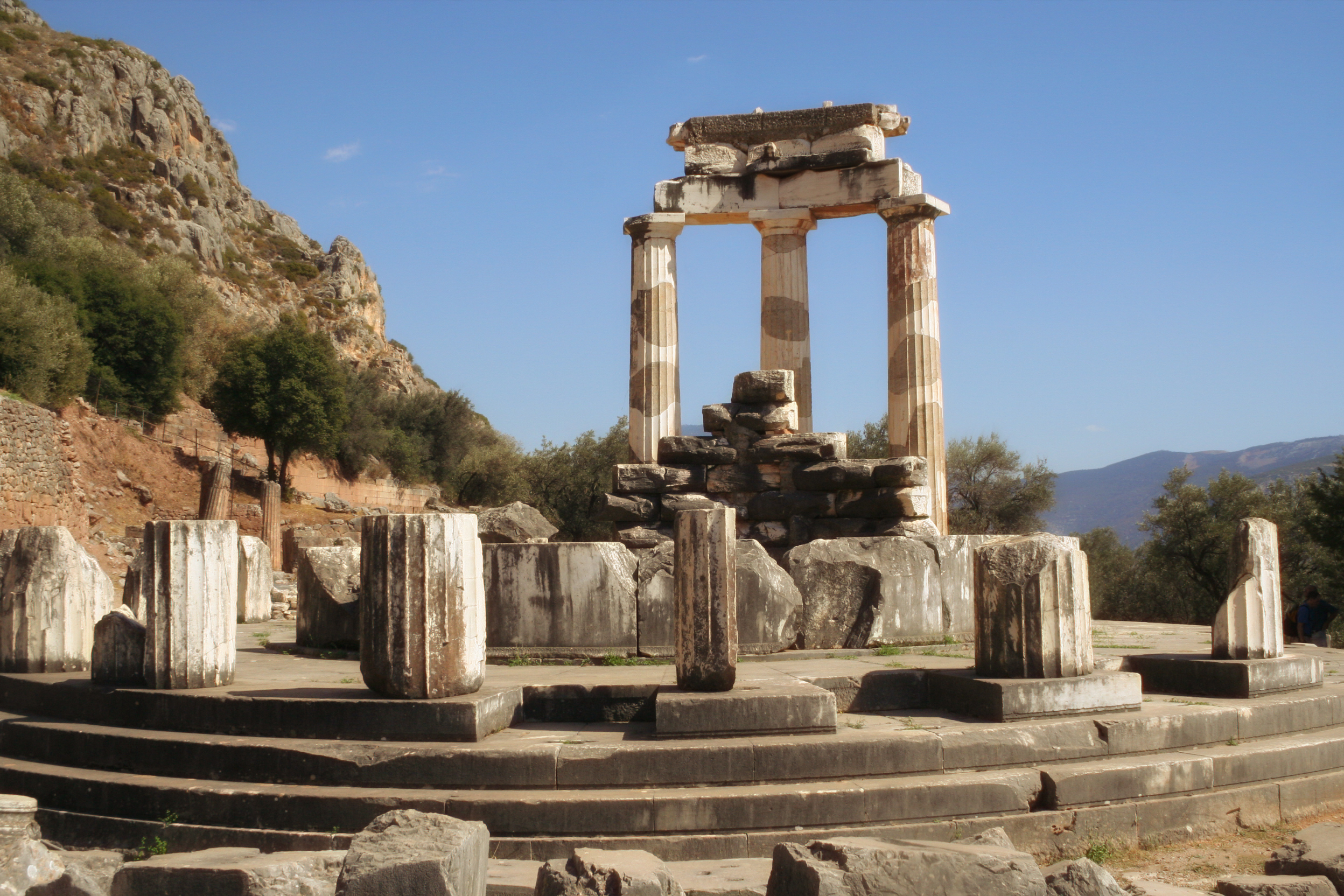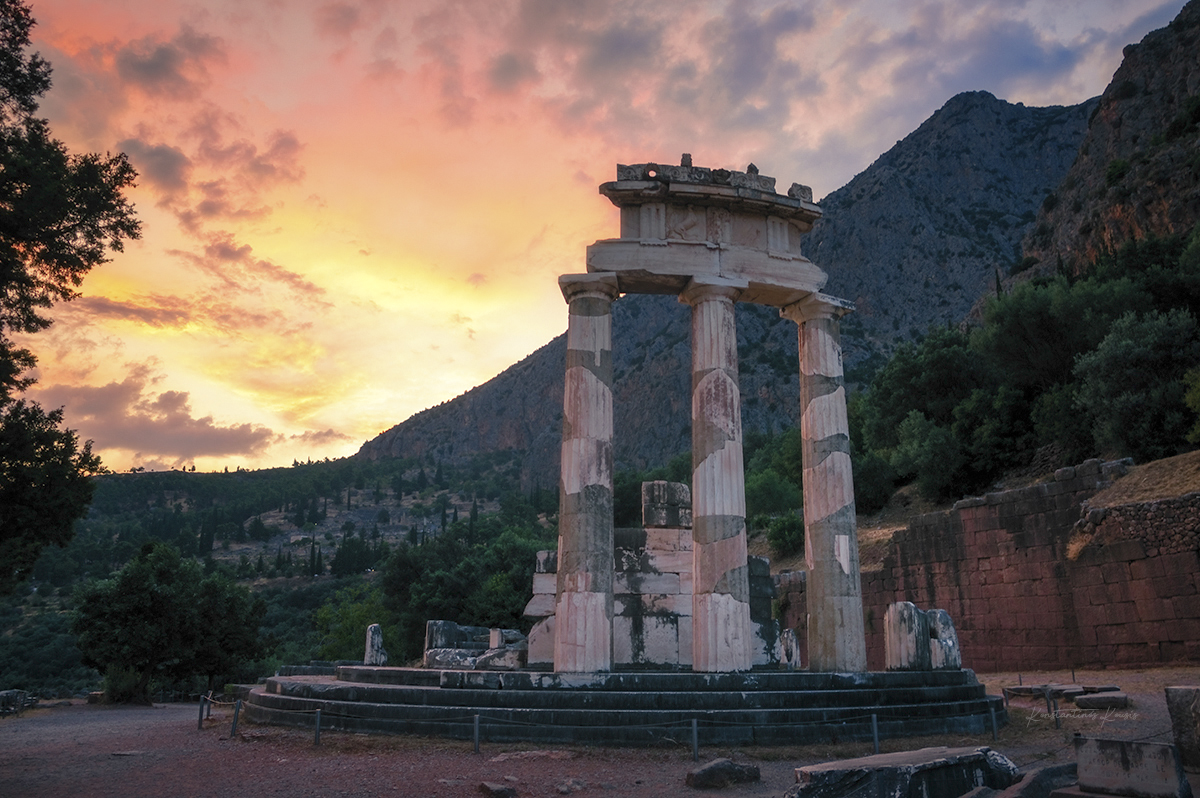Tholos Of Delphi on:
[Wikipedia]
[Google]
[Amazon]

 The Tholos of Delphi is among the ancient structures of the Sanctuary of
The Tholos of Delphi is among the ancient structures of the Sanctuary of 
Βαγγέλη Πεντάζου - Μαρίας Σαρλά, ''Δελφοί'', Β. Γιαννίκος - Β. Καλδής Ο.Ε., 1984, σελ. 138 - 139.Πάνος Βαλαβάνης, Ιερά και Αγώνες στην Αρχαία Ελλάδα. Ολυμπία – Δελφοί – Ίσθμια – Νέμεα – Αθήνα, Αθήνα, 2004
 The Tholos of Delphi is among the ancient structures of the Sanctuary of
The Tholos of Delphi is among the ancient structures of the Sanctuary of Athena
Athena or Athene, often given the epithet Pallas, is an ancient Greek goddess associated with wisdom, warfare, and handicraft who was later syncretized with the Roman goddess Minerva. Athena was regarded as the patron and protectress of ...
Pronaia in Delphi
Delphi (; ), in legend previously called Pytho (Πυθώ), in ancient times was a sacred precinct that served as the seat of Pythia, the major oracle who was consulted about important decisions throughout the ancient classical world. The oracle ...
. The circular temple, a tholos, shares the immediate site with other ancient foundations of the Temple of Athena Pronaia
The Temple of Athena Pronaia was a temple at the ancient site of Delphi, in the Sanctuary of Athena Pronaia, a group of buildings comprising temples and treasuries as well as the famous Tholos of Delphi. There were in fact three successive temples ...
, all located less than a mile east of the main ruins at Delphi, in the modern Greek regional unit of Phocis
Phocis ( el, Φωκίδα ; grc, Φωκίς) is one of the regional units of Greece. It is part of the administrative region of Central Greece. It stretches from the western mountainsides of Parnassus on the east to the mountain range of Vardo ...
. The tholos is part of the Delphi UNESCO World Heritage Site
A World Heritage Site is a landmark or area with legal protection by an international convention administered by the United Nations Educational, Scientific and Cultural Organization (UNESCO). World Heritage Sites are designated by UNESCO for h ...
.

Architecture
The architect of the "vaulted temple at Delphi" is named byVitruvius
Vitruvius (; c. 80–70 BC – after c. 15 BC) was a Roman architect and engineer during the 1st century BC, known for his multi-volume work entitled ''De architectura''. He originated the idea that all buildings should have three attribute ...
in ''De architectura
(''On architecture'', published as ''Ten Books on Architecture'') is a treatise on architecture written by the Roman architect and military engineer Marcus Vitruvius Pollio and dedicated to his patron, the emperor Caesar Augustus, as a guide f ...
'' Book VII as Theodorus Phoceus (not Theodorus of Samos
Theodorus of Samos () was a 6th-century BC ancient Greek sculptor and architect from the Greek island of Samos. Along with Rhoecus, he was often credited with the invention of ore smelting and, according to Pausanias, the craft of casting. He is ...
, whom Vitruvius names separately).
Externally, twenty Doric Doric may refer to:
* Doric, of or relating to the Dorians of ancient Greece
** Doric Greek, the dialects of the Dorians
* Doric order, a style of ancient Greek architecture
* Doric mode, a synonym of Dorian mode
* Doric dialect (Scotland)
* Doric ...
columns supported a frieze
In architecture, the frieze is the wide central section part of an entablature and may be plain in the Ionic or Doric order, or decorated with bas-reliefs. Paterae are also usually used to decorate friezes. Even when neither columns nor ...
with triglyph
Triglyph is an architectural term for the vertically channeled tablets of the Doric frieze in classical architecture, so called because of the angular channels in them. The rectangular recessed spaces between the triglyphs on a Doric frieze are ...
s and metope
In classical architecture, a metope (μετόπη) is a rectangular architectural element that fills the space between two triglyphs in a Doric frieze, which is a decorative band of alternating triglyphs and metopes above the architrave of a bu ...
s. The circular wall of the cella
A cella (from Latin for small chamber) or naos (from the Ancient Greek, Greek ναός, "temple") is the inner chamber of an ancient Greek temple, Greek or Roman temple in classical antiquity. Its enclosure within walls has given rise to extende ...
, the central chamber of the building, was also crowned by a similar frieze, metopes, and triglyphs, but to a lesser extent. Inside, a stone bench was positioned on which stood ten Corinthian Corinthian or Corinthians may refer to:
*Several Pauline epistles, books of the New Testament of the Bible:
**First Epistle to the Corinthians
**Second Epistle to the Corinthians
**Third Epistle to the Corinthians (Orthodox)
*A demonym relating to ...
style pilasters, all of them attached to the concave surface of the wall.
The manifold combination and blending of various architectural orders
An order in architecture is a certain assemblage of parts subject to uniform established proportions, regulated by the office that each part has to perform.
Coming down to the present from Ancient Greek and Ancient Roman civilization, the arch ...
in the same building was completed through a natural polychromatic effect, resulting from the use of different materials. Materials used included Eleusinian thin slabs (called "titanolithos") and Pentelic marble in the superstructure and limestone at the platform. The building's eight-arched roof was also constructed of marble, and was decorated respectively by eight female statues carved in sharp and lively motion.
The sculptures on the dome
The sculptured decoration of the dome was also beautifully crafted by hitherto unknown craftsmen. It is dated between 380 and 370 BC. High reliefs ascribed the figures of the metopes, which contributed to being easily detached from the plates and be reused as building material and tomb covers in the early Christian years after they were smoothed over again. Following strenuous and time-consuming efforts of specialists who attempted to agglutinate the fragments around the monument, we can today have at least an incomplete picture of its original form and the stylistic and decorative elements of its relief representations. In the major metopes of the outer side there are scene representations from Amazon and Centaur battles, already known from mythology and very dear toGreek sculpture
The sculpture of ancient Greece is the main surviving type of fine ancient Greek art as, with the exception of painted ancient Greek pottery, almost no ancient Greek painting survives. Modern scholarship identifies three major stages in monumen ...
. In the inside, the figures of the frieze survived unfortunately at a very small scale and with high fragmentation. They allegedly portrayed labors, either by Hercules
Hercules (, ) is the Roman equivalent of the Greek divine hero Heracles, son of Jupiter and the mortal Alcmena. In classical mythology, Hercules is famous for his strength and for his numerous far-ranging adventures.
The Romans adapted the Gr ...
or Theseus
Theseus (, ; grc-gre, Θησεύς ) was the mythical king and founder-hero of Athens. The myths surrounding Theseus his journeys, exploits, and friends have provided material for fiction throughout the ages.
Theseus is sometimes describe ...
.
Despite their fragmentary nature, the architectural reliefs on the Dome of Delphi reveal the great skill of their creators, as regards both the treatment of materials – especially marble – and catching details with vitality and excellent anatomical accuracy. All these novel compounds with unexpected combinations in the iconographic tradition of the 4th century BC introduce an innovative artistic movement, resulting in a creative competition between the art of relief and sculpted plastic art. Particularly to achieve the above confrontational blending of antithetical elements, the discernible elements include the high relief which may be detached from the plate of the panel, the kinesiological freedoms of the sculptures achieved through their details, as well as the dramatic intensity reflected in the figures to demonstrate the passion and the fury of the conflict of enemies in lively battle scenes.Ροζίνα Κολώνια, Το Αρχαιολογικό Μουσείο Δελφών, Κοινωφελές Ίδρυμα Ιωάννη Σ. Λάτση, Ολκός, 2006, σελ. 307.Βαγγέλη Πεντάζου - Μαρίας Σαρλά, ''Δελφοί'', Β. Γιαννίκος - Β. Καλδής Ο.Ε., 1984, σελ. 138 - 139.Πάνος Βαλαβάνης, Ιερά και Αγώνες στην Αρχαία Ελλάδα. Ολυμπία – Δελφοί – Ίσθμια – Νέμεα – Αθήνα, Αθήνα, 2004
See also
*Pausanias' description of Delphi
The tenth book of the work ''Description of Greece'' by the traveler Pausanias (2nd century AD) is dedicated to Phocis; its larger part constitutes a description of the sanctuaries and buildings of Delphi. His work constituted a precious aid to t ...
References
External links
{{Authority control Ancient Greek buildings and structures in Delphi Temples of Athena 4th-century BC religious buildings and structures